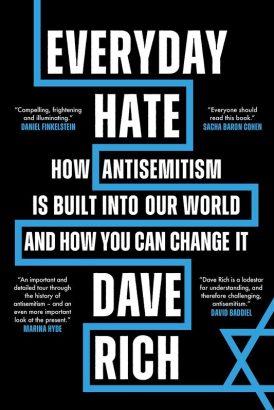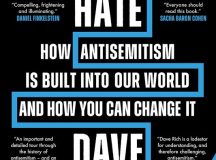Everyday Hate’s clarity and engaging style make it an invaluable introduction to antisemitism; however, it also has plenty to offer readers who already possess a more confident grasp of the topic. The very precise full title – in particular, that phrase ‘built into’ – indicates a key strength of the book. Dave Rich doesn’t simply define and analyse the tropes of antisemitism, he illuminates the subtle and complex mechanisms which sustain it: the factors behind its potency and longevity, the insidious ways in which it draws people in unwittingly, its capacity to re-erupt after a period of apparent dormancy, and of course its adaptability, its power to mutate and evolve as the world changes.
The preface opens with a powerful reminder as to just why antisemitism matters, offering a catalogue of examples of antisemitic abuse and rhetoric from just one seven-day period, moving from events in the UK to the international stage (xi-xiv). Striking individual examples are reinforced by clear statistics and sharp analysis. As well as demonstrating the sheer scale and significance of the problem, the case studies accumulate in a way which highlights recurring, centuries-old motifs within antisemitism – such as the urge to scapegoat, and accusations of dual loyalty. The drive to find fault with Jews, and blame them for local or global ills, is mirrored in the perhaps still more bizarre impulse to designate any enemies as Jews, in defiance of logic or evidence. This is just one of the book’s powerful and distinctive running themes. It’s not the most obvious feature of antisemitism, but it unites ISIS labelling moderate Muslims ‘Jews’ (xiii), Edmund Burke blaming the French Revolution on ‘Jew brokers’ (31) and the casual use of slurs such as ‘to Jew down’ (2). As Rich observes: ‘You don’t need a Jew in the conversation for the “Jew” insult to be deployed. Engrained within our own language is the assumption that being thought of as a Jew is something for everyone else to avoid.’ (3)
Dave Rich reaches out to readers with a limited knowledge of antisemitism. Although himself an expert in the field, he understands that, for many, its tropes are unfamiliar and puzzling. As he dryly notes after tracing the origins of the ‘blood libel’: ‘who remembers this history now? Jews and antisemites, mainly.’ (xix) Addressing the reader directly, he observes how easy it is for even well-meaning people to be drawn into antisemitic patterns of thought. This is a crucial point. It is understandable that someone might feel angry or defensive if accused of antisemitism. Rich invites such people not to beat themselves up, but to reflect and learn more: ‘If, when reading this book, you recognise things within yourself or people you know, don’t be too alarmed. It means it’s working.’ (xx) Rich goes on to explain in more detail precisely how and why people can be led astray, become carriers of the virus. Conspiratorial patterns of thought can all too easily become enmeshed in antisemitism even when that is not the original intended target (xxv-vi). Someone who doesn’t know the Rothschilds are Jewish can be the unwitting conduit of a meme from an antisemitic source which can then be picked up and amplified by antisemites (27). Those who might consider themselves philosemites can become vectors for antisemitic tropes when they express admiration for a Jewish stereotype such as the ability to make money (33-4). ‘Antisemitism has a fluid quality, filling whatever space is opened to it, permeating the cracks in society and widening them further.’ (xxviii) This is one of the many vivid and expressive metaphors which Rich deploys to impress the book’s complex arguments on the reader’s mind.
Although many of the examples invoked are extremely topical, connections are repeatedly drawn with much earlier manifestations of antisemitism. The reader becomes aware of the complex network of roots from which virulent new shoots continue to spring. Every modern instance of antisemitism has a clear line of ancestry. In Chapter Three, for example, we learn how the Grenfell Tower tragedy immediately prompted some to identify sinister connections with myths of Jewish ritual sacrifice (40). Rich goes on to explain how this particular trope – the blood libel – was revived in the nineteenth century by the myth of the vampire, which ‘draws implicitly on anti-Jewish motifs’ (50), and then much more recently by QAnon conspiracies about child trafficking (51). Dave Rich’s first book was a study of antisemitism on the left (reviewed here), and at this point he brings in a comparatively overlooked example of Jeremy Corbyn’s antisemitism problem. In 2011 Raed Salah was excluded from Britain partly on the basis of a 2007 speech which invoked the blood libel. Jeremy Corbyn supported Salah, and campaigned against the ruling (which was eventually overturned). At this point Rich introduces a personal note into his analysis, recalling a time he was asked by a left-wing journalist if he really thought Salah was antisemitic:
It is difficult to convey how infuriating it was to have to justify, to avowed anti-racists writing for progressive media outlets, why Salah’s invocation of the blood libel was such a problem for Jews. Why this wasn’t just an excuse we’d come up with to slander a fierce critic of Israel, but a real, visceral fear of the influence Salah’s medieval Jew-hatred could have on his British audiences. It felt very lonely. (56-7)
I think many readers will share his sense of frustration when faced with this lack of curiosity, this kneejerk mistrust, from precisely those who ought to be most attuned to racism.
The book is full of unexpected connections. Rich notes that it may seem anomalous to compare the anarchic cartoon South Park with Shakespeare’s The Merchant of Venice, but points out that both ‘have done their bit to inscribe the image of the rich, greedy Jew into the popular imagination’ (15). As his own analysis indicates, both also may confuse the viewer. Are they, or are they not, antisemitic? There’s a troubling ambiguity in South Park. We may feel invited to interpret the depiction and treatment of a Jewish character, Kyle, as a satirical swipe at antisemitism, albeit an edgy one, but the impact on other viewers may be to promote antisemitism (8-10). Similarly, despite being a brilliant and compelling drama and despite the many good arguments which can be adduced in favour of its being a critique of antisemitism, Rich insists that The Merchant of Venice ‘is a grossly antisemitic play, full of spiteful contempt for Jews’ (18). Later Rich discusses the more lurid antisemitism of Chaucer’s ‘Prioress’s Tale’, and notes how the edition of The Canterbury Tales he was given as a Chanukah present by his parents managed to both gloss over and reinforce the text’s racism (59-60).
In Chapter Six, Rich writes particularly powerfully about the experiences of antisemitism’s historical victims. Those fleeing from pogroms, or from the Holocaust, were often viewed with suspicion by the authorities in Britain and elsewhere – when they were allowed to enter the country in the first place. He warns against the dangers both of trivialising the Holocaust and of over-universalising it: ‘It wasn’t pure chance that it was the Jews, amongst all non-Aryan peoples, who were earmarked for total destruction’ (162-3). As well as exploring the complex history of antisemitism which made the Holocaust possible, Rich reminds his readers of the shameful list of countries who refused to help Jews in the 1930s, and of the many murderous attacks on Jews in the years just after WWII (165-6). These discussions give a particular force to the chapter’s closing reflections on the phrase ‘Never Again’, and its different resonances for Jews. ‘The legacy of all of this is an internalised Jewish version of “Never Again” that goes as follows: never again will we allow that to happen to us. Never again will we be so defenceless, relying on others for our safety who will not come when we need them. Never again will we fail to heed the warning signs. Been there, done that, never going back.’ (170). This trenchant reminder acts as a powerful preface to the discussion of Israel, and its importance for Jews, in Chapter Seven, ‘Jerusalem’.
There are a good many points of contact between Everyday Hate and David Baddiel’s Jews Don’t Count (2021) (reviewed here). Both combine humour with anger, anecdote with analysis. An important difference lies in their treatment of Israel. Whereas Baddiel distances himself from Zionism, Rich takes great pains to explain and define the bond many Jews feel with Israel, and the numerous ways in which criticism of Israel can slide into antisemitism. Returning to Rich’s metaphor of a ‘fluid’ antisemitism, Israel is the prime example of a space which it can permeate and occupy. ‘Conspiracy theories about Israel and Zionism … latch onto pre-existing beliefs about how Jews behave, like a climber using footholds cut into the rock by those who have scaled the same mountain centuries before’ (90). Rich navigates the tricky boundary between legitimate criticism of Israel and antisemitism very carefully, and evinces a reluctance to rush to label vehement critics as antisemites (186) which is tempered by a concern at the scale and intensity of such criticism, when compared with attitudes to, say, Saudi Arabia or Turkey (180-81). The compulsion to see Israel’s hand behind so many unconnected wars and disasters echoes the much older drive to scapegoat Jews. He invokes the ‘magnetic pull’ (197) of Israel as an idea, particularly in the context of (cultural) Christianity, as one factor behind this disproportionate scrutiny.
As its title suggests, the final chapter, ‘Things can’t only get better’, doesn’t pull its punches when it comes to confronting the challenges facing Jews today. He notes a disturbing trend for antisemitism to be much more prevalent in younger age groups, even though on the whole the young tend not to be racist (225). This connects with two of the concerns raised in the book, the growth of conspiracy theories which may foster antisemitic patterns of thought, and a tendency for antiracist initiatives to overlook antisemitism or simply not understand what makes it distinctive. Antisemitism isn’t currently being monitored and measured effectively, and this gap needs to be tackled urgently (251). Rich has also noticed that Jewish parents are increasingly sending their children to Jewish schools to protect them from racism. This is understandable, yet sets up a vicious circle whereby non-Jews are decreasingly likely to have Jewish friends, and ever more likely to get information about Jews from conspiracy theories (230-2). Rich also identifies an alarming phenomenon whereby social media algorithms seems to push antisemitic material to users who are searching for quite different topics (237). Greater media literacy, he argues, is needed to overcome these challenges.
This is an excellent and welcome addition to the literature of antisemitism. Each chapter coalesces around a central theme or moment, often topical or familiar, and then brings in a wealth of vivid detail from different times and places. It is easy to imagine it being adapted into a successful television series, which would have the advantage of drawing in viewers who would be unlikely to pick up the book – yet who would have most to gain from absorbing its message.





































